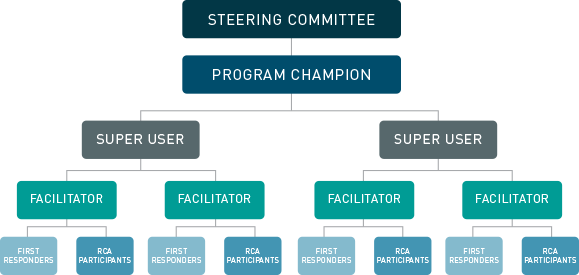Our previous article in this RCA Program Development blog series introduced the six roles required in your root cause analysis team in order cover all of the necessary functions. This installment in the series goes into more depth on the team structure and provides some important considerations for deciding whom should be involved.
The RCA effort in any organization will require a number of participants at various levels of the organization having distinct roles with very specific responsibilities. Once the workflow processes are established it is time to assign these roles and responsibilities to specific individuals, determine training needs, and decide if a formal human change management plan will be desirable to assist employees in assuming their new assignments. These responsibilities must be clearly understood to ensure that the appropriate personnel are assigned to the various roles which include the following:

To assist in the above, it is helpful to review the nature and dynamics of a functioning RCA team.
The role of an analysis team is to apply the RCA methodology to a particular incident. A predetermined set of conditions or triggers is used in determining what incidents qualify for a formal RCA. The RCA Champion in collaboration with a designated Facilitator then decides through the problem definition process how much effort is to be expended on the analysis i.e. what skills participants will be on the team and how many of each, based upon the severity of the incident. As a general rule, the cost of the resources expended should be significantly less than the potential benefit of a successful outcome. In other words, the effort should yield a favorable ROI or greatly reduce the risk of a safety or environmental incident recurrence. It is often useful to define threshold levels, or break points for minor, significant, or major RCA efforts to provide guidance.
The Facilitator leads the analysis process. Teams should be cross functional and consist of 6 to 8 members depending upon the nature, complexity, and severity of the incident under investigation. When assembling an RCA team, the Champion or Facilitator has the option of including people directly involved in the incident being analyzed on the team, or involve them as interviewees only. It is often beneficial to include a team member with no firsthand knowledge of the incident, but having familiarity with the process, equipment, etc. in order to help bring objectivity to the group and avoid "group think". These members need to be carefully selected to ensure they add value. Having people assigned to the analysis team because they are available will only waste time. The team should also have at its disposal all the facts, evidence, and a timeline surrounding the incident.
Certain points in the analysis may require additional information that is not available within the organization. For example, it may be necessary to contact suppliers or vendors concerning design issues. The incident owner will need to understand and encourage the follow-up on this type of information gathering.
When the RCA program is launched, it is recommended to focus on the quality of the analysis and not quantity. A few quick-wins are important to building momentum and confidence in the process.
Specific RCA team responsibilities include the following:
- Review the facts, evidence, and timeline surrounding the incident
- Interview eye witnesses or others that may have useful knowledge of the incident at hand but are not on the analysis team
- Interview subject matter experts
- Provide the technical expertise for problem solving including action and condition recognition and possible solution proposals
- Perform an RCA analysis. The Apollo Root Cause Analysis methodology includes:
- Validating the problem definition as previously determined by the Champion and Facilitator
- Creating the cause and effect diagram using RealityCharting® software
- Identifying conditions and actions that precipitated the incident under investigation
- Proposing effective solution to eliminate selected conditions and actions that are realistic and under the control of the facility’s management
- Summarize the findings in a report to the Champion to be presented to the Steering Committee. Be available to answer any question the Steering Committee may have regarding the report.
Once the roles and responsibilities are assigned, a comprehensive training plan covering the RCA methodology and any identified change management needs must be developed with a targeted timeline.
So far, this blog series has covered:
The Key Steps of Designing Your Program
Defining Goals and Current Status
Setting KPIs and Establishing Trigger Thresholds
RCA and Solution Tracking and Roles and Responsibilities
And, Recommended RCA Team Structure.
The next edition will review the specific responsibilities of the six RCA roles. Stay tuned for more.

